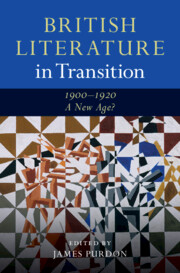Book contents
- British Literature in Transition, 1900–1920: A New Age?
- British Literature in Transition Series
- British Literature in Transition, 1900–1920: A New Age?
- Copyright page
- Contents
- Contributors
- General Editor’s Preface
- Acknowledgements
- Introduction
- Part I Nation and Empire
- Part II Media
- Part III Aesthetics
- Chapter 12 Transitions, Turns
- Chapter 13 Poetry and Transition
- Chapter 14 Realism and Mass Politics
- Chapter 15 Short Fiction
- Chapter 16 Ideals of a Picture Gallery
- Part IV Society
- Index
Chapter 16 - Ideals of a Picture Gallery
from Part III - Aesthetics
Published online by Cambridge University Press: 07 December 2021
- British Literature in Transition, 1900–1920: A New Age?
- British Literature in Transition Series
- British Literature in Transition, 1900–1920: A New Age?
- Copyright page
- Contents
- Contributors
- General Editor’s Preface
- Acknowledgements
- Introduction
- Part I Nation and Empire
- Part II Media
- Part III Aesthetics
- Chapter 12 Transitions, Turns
- Chapter 13 Poetry and Transition
- Chapter 14 Realism and Mass Politics
- Chapter 15 Short Fiction
- Chapter 16 Ideals of a Picture Gallery
- Part IV Society
- Index
Summary
This chapter examines the relationship between literature and visual cultures between 1900 and 1920 through the different forms of art writing practised by a range of literary and cultural figures. Museums and art galleries witnessed a surge in popularity during the late nineteenth and early twentieth centuries as collections expanded and opened up to a wider viewing public, while exhibitions such as the post-impressionist exhibition of 1910 have come to be seen as cultural landmarks in narratives of the period. This essay explores writers’ encounters with artworks and artefacts in the contested yet stimulating spaces of museums and galleries, and examines the ways in which such encounters helped to frame questions about aesthetics and cultural identity, history and the contemporaneous. It takes in the role of periodical cultures – focusing on Rhythm (1911–13), Blast (1914–15), and Colour Magazine (1914–32) – in mediating responses to visual art and as sites in which the demarcations between word and image could be redefined.
- Type
- Chapter
- Information
- British Literature in Transition, 1900–1920: A New Age? , pp. 295 - 312Publisher: Cambridge University PressPrint publication year: 2021

